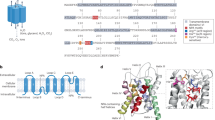Abstract
In many epithelia, the rate of NaCl reabsorption is determined by the activity of a Na+ transport system in the outer (apical) membrane. In frog skin and toad bladder, this system is thought to involve transmembrane pores through which Na+ ions move down an electrochemical activity gradient1–5. It has been shown, however, that increased intracellular Na+ concentration leads to reduction in unidirectional Na+ influx6,7, raising the possibility that ions do not move through the channel independently. The Ussing flux ratio equation is one test for independence of passive ion movements8. In particular, single-filing of ions through long pores can account for effects such as reduction of unidirectional fluxes by ions on the opposite (trans) side of the membrane; this type of transport mechanism is characterized by flux ratio exponents >1 (refs 9–11). I have evaluated the flux ratio exponent (n′) for the apical Na+ channel in the toad bladder as the ratio of tracer permeability to electrical conductance at electrochemical equilibrium9–11, that is, n′=RT/F2(GNa/JNa), where JNa and GNa are, respectively, unidirectional flux and the conductance for Na+ions through the channel in the absence of net Na+ movement. I report here values of n′ of 1.15±0.10 and 1.08±0.07 for activities of 40mM and 10 mM Na+, respectively, in the outer solution. This channel is therefore occupied by at most one Na+ ion at these activities.
This is a preview of subscription content, access via your institution
Access options
Subscribe to this journal
Receive 51 print issues and online access
$199.00 per year
only $3.90 per issue
Buy this article
- Purchase on Springer Link
- Instant access to full article PDF
Prices may be subject to local taxes which are calculated during checkout
Similar content being viewed by others
References
Lindemann, B. & Van Driessche, W. Science 195, 292–294 (1977).
Van Driessche, W. & Lindemann, B. Nature 282, 519–520 (1979).
Li, J. H.-Y., Palmer, L. G., Edelman, I. S. & Lindemann, B. J. Membrane Biol. 64, 77–90 (1982).
Palmer, L. G., Li, J. H.-Y., Lindemann, B. & Edelman, I. S. J. Membrane Biol. 64, 91–102 (1982).
Fuchs, W., Hviid Larsen, E. & Lindemann, B. J. Physiol., Lond. 267, 137–166 (1977).
Erlij, D. & Smith, D. J. Physiol., Lond. 228, 221–239 (1973).
Chase, H. S. Jr & Al-Awqati, Q. J. gen. Physiol. 77, 693–712 (1981).
Ussing, H. H. Acta physiol. scand. 19, 43–56 (1949).
Hodgkin, A. L. & Keynes, R. D. J. Physiol., Lond. 128, 61–88 (1955).
Heckmann, K. Biomembranes 3, 127–153 (1972).
Hille, B. & Schwartz, W. J. gen. Physiol. 72, 409–442 (1978).
Palmer, L. G., Edelman, I. S. & Lindemann, B. J. Membrane Biol. 57, 59–71 (1980).
Warncke, J. & Lindemann, B. Adv. physiol. Sci. 3, 129–133 (1980).
Biber, T. U. L. & Curran, P. F. J. gen. Physiol. 56, 83–99 (1970).
Thompson, S. M. & Dawson, D. C. J. Membrane Biol. 42, 357–374 (1978).
MacRobbie, E. A. C. & Ussing, H. H. Acta physiol. scand. 53, 348–365 (1961).
Grinstein, S. & Erlij, D. Proc. R. Soc. B202, 353–360 (1978).
Taylor, A. & Windhager, E. E. Am. J. Physiol. 236, F505–F512 (1979).
Frazier, H. S., Dempsey, E. F. & Leaf, A. J. gen. Physiol. 45, 529–543 (1962).
Aceves, J. & Cuthbert, A. W. J. Physiol., Lond. 295, 491–504 (1979).
Ussing, H. H., Eskesen, K. & Lim, J. in Epithelial Ion and Water Transport (eds MacKnight, A. D. C. & Leader, J. P.) 257–264 (Raven, New York, 1981).
Author information
Authors and Affiliations
Rights and permissions
About this article
Cite this article
Palmer, L. Na+ transport and flux ratio through apical Na+ channels in toad bladder. Nature 297, 688–689 (1982). https://doi.org/10.1038/297688a0
Received:
Accepted:
Issue Date:
DOI: https://doi.org/10.1038/297688a0
This article is cited by
-
Basolateral membrane potential and conductance in frog skin exposed to high serosal potassium
The Journal of Membrane Biology (1986)
-
Interactions of amiloride and other blocking cations with the apical Na channel in the toad urinary bladder
The Journal of Membrane Biology (1985)
Comments
By submitting a comment you agree to abide by our Terms and Community Guidelines. If you find something abusive or that does not comply with our terms or guidelines please flag it as inappropriate.



